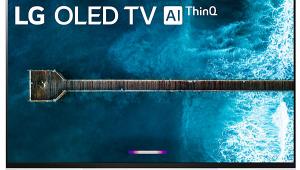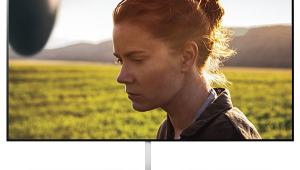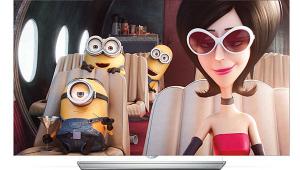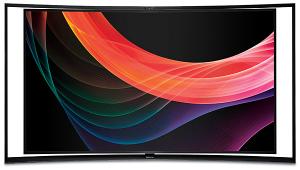As someone said at CNET when they reviewed this TV " 4K is just putting new tires on an old car. OLED is a whole new car. After owning 2 plasmas LED may be brighter but hardly the same picture quality. OLED solves the brightness problem and has an even better picture. Let's hope it sticks around.
LG 55EC9300 3D OLED HDTV
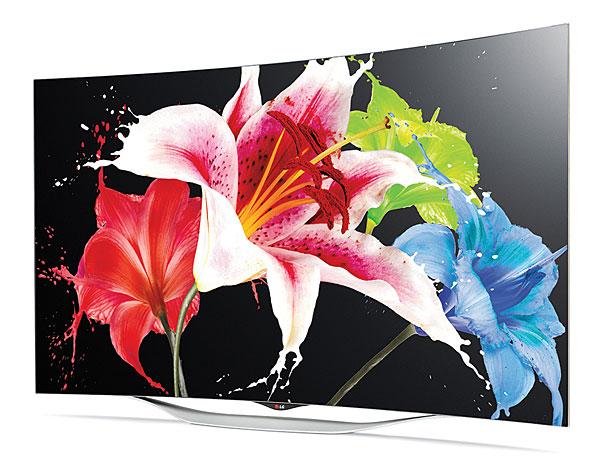
AT A GLANCE
Plus
Blacks, contrast, and shadow detail to die for
Lightweight
Minus
Not 4K
Cinema mode soft in default settings
THE VERDICT
This new LG is the OLED that videophiles have been waiting for, and an improvement over the 55EA9800 we reviewed last spring—with equal or better performance and, not least of all, a dramatically lower price.
Now that we’re about to turn the page into 2015, OLED HDTVs, so promising a year ago, appear to be at risk. The limited yield for OLED panels, resulting in a high retail cost, has driven most HDTV makers to the sidelines.
But not LG. They continue to vigorously support the technology. And with a current price of $3,500 [since dropped to $1,800—Ed] for the new 55EC9300, they’re clearly tossing a Hail Mary into a market crowded with cookie-cutter LCD sets. At 55 inches (diagonal), this may be a relatively small set for the price, and it’s still just “Full HD” (the industry buzzphrase for 1080p sets). Whether LG scores a touchdown or gets intercepted remains to be seen, but there’s no doubt that buyers will be the winners.
Under the Hood
OLEDs (Organic Light Emitting Diodes), much like the technology of plasma TVs but unlike conventional LCD sets (even when they’re misleadingly labeled LED TVs), are self-illuminating; the OLED pixels emit light when energized. When the image calls for an area of the screen to be black, the OLEDs in that area shut down completely, rendering that part of the screen totally black, not the dark gray typical of most sets short of locally dimmed LCDs.
With its gently curved, extremely thin screen and absurdly light weight (under 40 pounds), LG’s 55EC9300 is definitely a conversation starter. I found nothing negative to say about the curvature, apart from the fact that it may look a bit odd on a wall.
Unlike the LG 55EA9800 OLED I reviewed in our June issue, the 55EC9300’s sound quality lacks cavernous colorations. But it substitutes thin and nasal instead. It’s adequate audio, but not the equal of what you’d get from a modest external sound system or even a good soundbar—though the audio, of course, isn’t why you buy the ticket. If you do add a soundbar or alternate system, keep in mind that, like many other HDTVs, the LG’s Toslink optical digital audio output passes only two-channel stereo for connected DTS and Dolby Digital sources. It does not output multichannel sound.
The set offers both 2-point (high and low) and 20-point White Balance controls, plus a color management system. A Gamma control has three settings: 1.9, 2.2, and 2.4. The TV also has a Dynamic Contrast control, a carryover from the 55EA9800, which I found to be unusable on that model. It worked fine here set to low, where it subtly increased image pop without any negative impact on the basic picture quality.
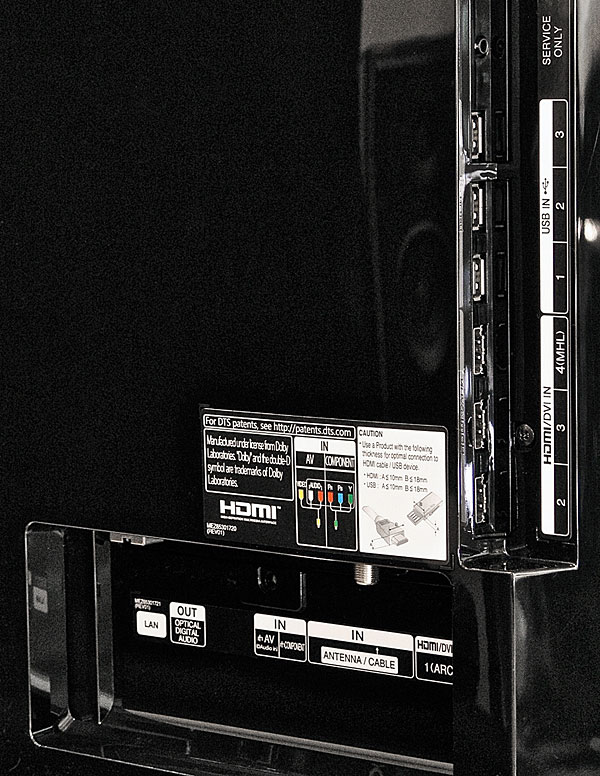
LG’s TruMotion feature offers frame interpolation to smooth out motion blur. The User mode (with its separate De-Judder control set to near zero and its De-Blur control near maximum) was a bit less aggressive than the other settings in making film-based material look like an old episode of As the World Turns. But most of the time, I left it off.
LG has slightly improved the company’s wand-shaped Magic Remote. If you’ve read my prior LG reviews, you know I’m not a fan. Previously, the remote would drift so much that I had to recalibrate it constantly for accurate centering. This time around, I only had to do this every five minutes or so. But it now combines enough direct-control buttons supplementing its motion shtick to make it tolerable, though still not lovable. It also offers voice recognition; I couldn’t get this feature to work for me, but if you find this a deal-breaker, you’re reading the wrong review. You can also download an LG app to control the set via a smartphone or tablet (not tested).
These days, a TV has to be more than just a TV. It’s a portal. LG’s SmartShare lets you enjoy photos, music, or videos stored on either your home network or a USB source. And LG’s Smart TV feature opens the usual extensive range of Internet goodies, using either a wired or (in my case) wireless connection via the set’s built-in Wi-Fi receiver. With the latter, I spent most of my time on Amazon Prime Instant Video and was pleased with how impressive the best material (though not all of it) looked.
The 55EC9300, like other LG sets, uses lightweight and inexpensive passive 3D glasses. The set comes with four pair—two of them con- ventional, the other two clip-on (hooray!). List price on an extra 4-pack is $30. The set also offers 2D-to-3D conversion and a 2D Dual Play gaming feature. The latter allows two players, wearing special optional glasses (not the standard 3D variety), to view just their part of the action on the full screen.
Setup and Performance: 2D
The LG’s color wasn’t far off out of the box, but a full calibration did make a significant measured improvement and a noticeable visual one. The 2-point White Balance menu was sufficient; although I did use some of the 20-point controls, I found that after I exited the menu, the measured improvement they offered when the menu was open disappeared. The color gamut was also more than acceptable out of
the box, though a few tweaks to
the color management system improved it further.
With the Real Cinema control on, the LG sailed through all of our standard video-processing tests with some of the cleanest results we’ve seen. The LG’s off-axis performance is also as good as any plasma’s. The set can be viewed from any practi- cal viewing angle with no visible degradation.
A screen-filling, bright-white field on a plasma set is always measurably dimmer than an image at the same level that doesn’t fill the screen (such as a window pattern). With an LCD, the brightness of both patterns will be virtually the same. The LG OLED performs much like a plasma in this respect. The main effect of this is that if you view an LCD side by side with this TV (or a plasma) and adjust both sets for the same peak white level on a window pattern, the LCD will look much brighter with a bright, full- screen image. But as with a plasma, this produces no visible changes on real program material.
After calibration (or even before, on our sample), the LG’s color was hard to fault. Fleshtones were right, green foliage never looked fluor- escent, and reds popped naturally. Wider color gamuts are coming to Ultra HD sets, if the road to full UHDTV doesn’t veer off course. But for today’s 2K Full HD sets (like this one), Rec. 709 remains the standard, and the LG can do Rec. 709 color as well as any other set we’ve reviewed.
- Log in or register to post comments

I have this TV on my showroom and let me say the picture is wonderful. The contrast is simply amazing. My only issue really is LG did not make the TV VESA compliant for wall mounting. You have to buy there fixed mount for the TV Which has swayed several customers away from buying. I also feel the TV has a very soft picture and almost seems just ever so slightly out of focus sometimes. Thats a personal prefference i believe tho. I have sold TV's and Home Theater for 15 years now and this TV is by far the Best picture ever! I am also predicting LG to takeover as the #1 TV brand because of OLED and samsung will have to take the backseat for now.

Thomas thank you for great reviews on both TVs. I want to ask you for your opinion on the matter of buying a new TV in upcoming months...
I have to buy TV this year because I don't have one (I'm still living with my parents) so I can't wait for 4k OLEDs to come down to a reasonable price (maybe late 2016?).
But I can't really decide whether these perfect blacks and contrast are more important for 'immersion' than more inches of diagonal.... I'm thinking about something like 65" HU7500 samsung... I know its blacks are worse then OLED, but I don't think they are really bad or something are they? Because I have a feeling that 55 inches is not that large (my viewing distance will be about 2.8m) and I don't know whether these super blacks will compensate enough for that smaller diagonal. This cannot be decided in a shop, because there is bright environment so I just have to believe others who have more experience with these sets.
What is your opinion, is the OLED that much better experience that it is OK to sacrifice quite significantly larger picture frame for that? I want this TV to last 5+ years (so maybe 4k ready for HFR can be usefull?)...
Thank you very much in advance.

I have read articles reviewing the LG 55EC9300 and I've visited several showrooms to view this TV. The picture really stands out...blacks are amazing...colors are stunning. The price has been lowered to $2999.99 among competitors, making this beautiful set more appealing. I'm very excited about the OLED technology. However, yesterday I realized it's not quite ready. I observed the dreaded burn-in on a display model. I could clearly read the word "SETUP" burned-in to the display in a band across the lower portion of the screen.
I bought a different brand of 4K UHDTV.
Your reviews and are extremely helpful. I also appreciate your "HOW TO" section. Thank you.




